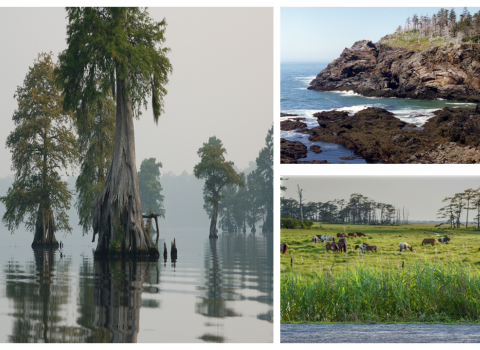Investing in wildlife means investing in people. We at the U.S. Fish and Wildlife Service understand that conservation of America’s public lands involves more than waterfowl surveys and wetland restoration. It also involves fostering community. Take a moment to meet Cassie Skaggs, the new refuge manager for two of the youngest national wildlife refuges in the country, and learn about her vision for making a future for everyone to enjoy their public lands.
Sometimes you don’t know that something is special or rare, until you leave it. That’s the case for Cassie Skaggs, the new refuge manager for Kankakee National Wildlife Refuge and Conservation Area and Hackmatack National Wildlife Refuge in Illinois. Born and raised on the coastal plain of southwest Georgia, about three hours southwest of Atlanta, Skaggs grew up with her sister exploring the Flint River Floodplain and swimming in crystal-clear springs. Together, they’d fish, hike, turn over rocks to see what might crawl out and look for fossils in the limestone. Simple interactions with wildlife, like spotting a glimpse of the gopher tortoise that had made a home in her childhood garden, now hold more significance for Skaggs. Reflecting on those formative years, Skaggs noted that it wasn’t until she started volunteering at the local zoo during her high school years that she realized how special gopher tortoises were as a keystone species in the longleaf pine-wiregrass ecosystem. This ecosystem once covered about 90 million acres in the southeast, of which less than 5% remains.
Skaggs got her introduction to the U.S. Fish and Wildlife Service in 2012 as a University of North Dakota biological research technician working at Agassiz National Wildlife Refuge in northern Minnesota. She found her calling those summers at the refuge with moose, elk, bears, wolves and lots of ducks but made important connections with the people behind the conservation. These experiences inspired her to one day become a refuge manager. The path from academic pursuit of conservation to that of a career meandered from the prairie pothole region, south to the oak hickory upland forest and bottomland hardwood forest of Crab Orchard National Wildlife Refuge. Here, she worked as a wildlife refuge specialist, where her main duties involved facilitating the agriculture program, reviewing pesticide use proposals and assisting with the biological program.
Inspiring her journeys as Skaggs crisscrossed the country was the model that her mom set. Be independent, be determined and always believe in yourself. This internal compass was further fortified by all sorts of mentors from within the agency. One who stands out for Skaggs is Maggie Anderson, past refuge manager of Agassiz National Wildlife Refuge and ardent conservationist. Even though Anderson had recently retired, she jumped in to assist Skaggs whether it was out in the field on bufflehead duck surveys or offering career advice, as Skaggs was fresh out of her undergraduate studies from the University of Georgia at the time.
In her new role, Skaggs is stewarding two young national wildlife refuges in Illinois - Hackmatack National Wildlife Refuge, established in 2012, and Kankakee National Wildlife Refuge and Conservation Area, established in 2016. Even though they have different geographies, these refuges have the same mission – to work with others to conserve, protect and enhance fish, wildlife and plants and their habitats for the continuing benefit of the American people. While Skaggs has the support of folks who love the special places that she’s charged with managing, the path she follows next is largely unknown. By approaching this task with humility and openness, Skaggs is welcoming wisdom and advice from local communities.
Looking back at her formative years that were shaped by being outside, Skaggs hopes these protected places provide similar opportunities for generations to come. This doesn’t necessarily mean growing the footprint larger than it is currently, it means growing local pride in having a national wildlife refuge national wildlife refuge
A national wildlife refuge is typically a contiguous area of land and water managed by the U.S. Fish and Wildlife Service for the conservation and, where appropriate, restoration of fish, wildlife and plant resources and their habitats for the benefit of present and future generations of Americans.
Learn more about national wildlife refuge in the community. She also aims to learn from folks about their connections with these landscapes. Skaggs recognizes that while she’s new to these special places, generations of people have their own personal connections to the area, and she is hopeful that over time, they will share their love of these places.




